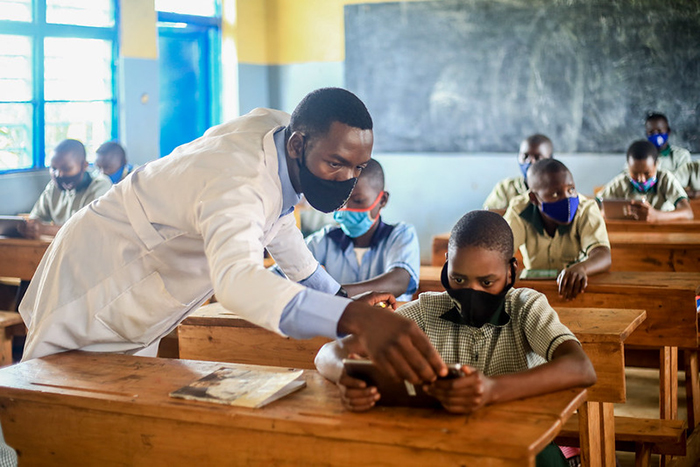Ibero-American education systems are facing an unprecedented challenge: the effective integration of digital technologies in classrooms. The COVID-19 pandemic not only shook the foundations of global health and economic systems but also accelerated an educational transformation that had been gradually emerging. With schools closed and lessons moved to digital platforms, a worrying reality became apparent: more than 40% of children and young people in the region had no access to the internet or devices during the pandemic. And only 50% of those with access to these resources were able to participate in any form of learning activity.
This emergency context highlighted that traditional education is no longer enough to meet the challenges of the 21st century. Digitalisation, which has already transformed sectors such as banking, commerce, and entertainment, now presents itself as a necessary step in education. In this scenario, the Organisation of Ibero-American States (OEI) has published a report titled Teacher Digital Competence for Educational Transformation, which brings a crucial issue to the forefront: the preparation and training of teachers in digital competences. The underlying question is clear: are our teachers ready for this new educational reality?
The Need for Pedagogical Transformation
One of the report’s key arguments is that while technological infrastructure is essential, it is not enough to ensure real transformation in education. The arrival of computers and internet access in schools will not, by itself, resolve the structural problems. As the OEI publication points out, “A hybrid education model must go hand in hand with a genuine pedagogical transformation.” This change involves reviewing curricula, incorporating new methodologies, and creating learning environments that combine in-person and virtual education.

Digitalisation is not simply about moving from textbooks to digital formats or from physical classrooms to virtual ones. It requires a profound reassessment of how teaching and learning are conducted. Digital tools allow for more personalised, flexible, and collaborative learning, but only if teachers are trained to make the most of them.
At this point, the report focuses on teachers, who play a key role in the transformation. According to the study, many teachers have yet to receive adequate training in digital competences. This not only affects their ability to use technological tools but also their ability to integrate them effectively into teaching. In an increasingly digitalised environment, teacher digital competence becomes an essential element for educational success.
Teachers must be able to manage digital learning environments, design educational activities using technological tools, promote online collaboration among students, and assess learning digitally.
The Concept of Teacher Digital Competence: More Than Just Using Technology
The concept of digital competence has evolved significantly in recent decades. In the 1990s, it was limited to knowing how to use a computer and a projector in the classroom. Over time, it has expanded to include aspects such as the pedagogical integration of technology, the creation of digital resources, information management, and the ability to guide students in the responsible use of digital tools.
Today, teacher digital competence involves much more than handling devices. According to the report, teachers must be able to manage digital learning environments, design educational activities using technological tools, promote online collaboration among students, and assess learning digitally. Additionally, they must be prepared to teach students how to navigate the vast amounts of information available online, helping them develop critical thinking skills to distinguish between reliable sources and false content.
In this regard, information overload has become an increasing challenge. The internet offers an unlimited volume of information, but not all of it is valid or useful. The so-called “infoxication,” or information overload, can confuse both students and teachers. This is where the teacher’s role as a guide becomes even more important: it is not enough to provide access to technology; it is necessary to teach students how to use it effectively and critically.
The Digital Usage Gap
One of the report’s most relevant points is its analysis of the digital divide. Traditionally, this concept has been understood as the difference in access to technology among different sectors of the population. However, the report goes further and highlights the existence of a second divide: the usage gap. Although more and more students and teachers have access to technological devices, the way these are used varies significantly across social, economic, and geographic groups.
The report notes that some students, especially those from more privileged backgrounds, are able to use digital tools to deepen their learning, collaborate on online projects, explore new knowledge, and develop critical skills. In contrast, other students, from more vulnerable backgrounds, not only face difficulties in accessing technology but also lack the skills necessary to fully benefit from it. This creates an even greater inequality.
The report’s authors emphasise the need for public policies that not only ensure universal access to technology but also promote equitable use of these tools in the classroom. This means training teachers to identify the gaps in technology use and work to close them, offering additional support to the students who need it most.
The report’s authors emphasise the need for public policies that not only ensure universal access to technology but also promote equitable use of these tools in the classroom.
Continuous Training and Educational Policies: The Key to Bridging the Gap
Given this situation, what can education systems do to better prepare their teachers and ensure that all students, regardless of their background, have access to quality digital education? The report proposes several strategies, with continuous teacher training standing out as one of the most important.
The authors advocate for a systematic approach to digital training, starting in initial teacher education and continuing throughout their professional careers. This includes offering specific training programmes in digital competences, designing professional development policies that encourage pedagogical innovation, and creating networks of collaboration among teachers to share best practices.
However, for these policies to be effective, they must be accompanied by institutional commitment. Schools and educational authorities play a crucial role in creating an innovation ecosystem that supports teachers’ digital training. This includes providing adequate technological resources, access to online learning platforms, and spaces where teachers can experiment with new technology-based pedagogical methodologies.
Successful Examples: The Case of Estonia
Internationally, there are several examples of countries that have successfully integrated digital competence into their education systems. One of the most cited is Estonia, a country that, following its independence from the Soviet Union in 1991, decided to invest heavily in the digitalisation of its economy and education system. Today, Estonia is a world leader in digital education.
In Estonian schools, programming is taught from primary education, and teachers receive continuous training in digital competences. Moreover, internet access is guaranteed in all schools, and the use of digital platforms for collaborative learning is encouraged. As a result, Estonia has significantly reduced the digital divide and greatly improved the educational outcomes of its students.
This example shows that with the right political will and sustained investment, it is possible to transform education systems to meet the challenges of the 21st century. However, the Estonian case also highlights that success does not lie solely in technology but in creating a culture of innovation where teachers play a central role.
An Unavoidable Challenge
Digital transformation in education is not optional; it is a necessity. Ibero-American education systems must quickly adapt to technological changes if they want to prepare their students for the future. However, this process will not be possible without significant investment in teacher training.
As guides and facilitators of learning, teachers are the key players in this transformation. Only by developing strong digital competences and a pedagogy adapted to the digital environment can we ensure that all students have access to a quality, equitable, and inclusive education. The future of education depends on our ability to embrace digitalisation effectively and fairly, and teacher digital competence is the first step on this path.






